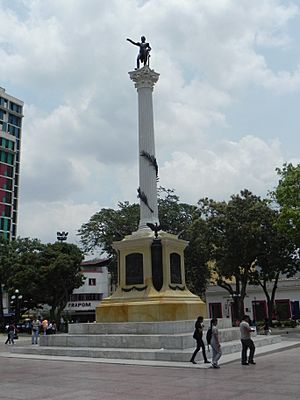Plaza Bolívar (Valencia) facts for kids
The Plaza Bolívar is a famous square in Valencia, Venezuela. It's a central spot where people gather for public events. This square has been important since the city was first built during the colonial period. Some buildings nearby, like the Cathedral, are also from that time.
The square was later named after Simón Bolívar in the 1800s. This happened after Venezuela became independent. At the center of the square is a tall, impressive column. It was officially opened in 1889. The column honors Bolívar and celebrates his big victory at the battle of Carabobo in 1821.
 |
|
| Type | Victory column |
|---|---|
| Material | Marble and bronze |
| Opening date | 24 June 1889 |
| Dedicated to | Simón Bolívar |
Contents
History of Plaza Bolívar
In the 1880s, when Valencia's monument to Bolívar was being built, Venezuela was mostly a farming country. Even though it had a lot of iron ore, the country couldn't make its own iron.
Antonio Guzmán Blanco was president of Venezuela three times. He had big plans to make the country's buildings and transport more modern. These projects greatly changed Valencia, which was the second-largest city.
He allowed a British company to build a railway between Valencia and the coast at Puerto Cabello. The train station in Valencia was at Camoruco, about 3 kilometers from the city center. There were also plans for a tramway, first pulled by horses, to reach Plaza Bolívar.
Guzmán Blanco also approved a railway from Valencia to Caracas, the capital. This railway, called the Great Venezuela Railway, was built by a German company. Its Valencia station was at San Blas, closer to the city center.
Building the Monument
In 1887, President Guzmán Blanco decided to improve the Plaza Bolívar in Valencia. The main part of the monument is a marble column. On top of it is a bronze statue of Bolívar.
This monument was part of a national effort to remember Bolívar. This effort began in the 1870s. For example, Guzmán Blanco also ordered a statue of Bolívar on horseback for the Plaza Bolívar in Caracas. He also made the bolívar the official money of Venezuela.

General Hermógenes López, who was governor of Carabobo State, supported the work on the column. He became president after Guzmán Blanco for a short time in 1887-1888. The monument was officially opened by the next president, Juan Pablo Rojas Paúl, on Carabobo Day in 1889.
Design of the Monument
The architect in charge of the project was Antonio Malaussena (1853–1919). Malaussena later designed Valencia's municipal theater, which opened in 1894. It was built in the fancy Napoleon III style.
The sculptor Rafael de la Cova created the detailed carvings at the base of the monument. These carvings, called bas-reliefs, show scenes from the Battle of Carabobo. Rafael de la Cova had studied art in Europe in the 1870s.
What the Imagery Shows
The statue of Bolívar shows him pointing south-west. This direction is towards the battlefield of Carabobo. This was his famous victory in 1821 during the Venezuelan War of Independence.
The bottom part of the monument has the shield of the State of Carabobo. It also has three bas-reliefs that show scenes from the battle:
- Bolívar guiding his soldiers
- The British Legions (volunteer soldiers who fought with Bolívar)
At each corner of the base, there are sculptures of Andean condors, which are large birds.
Protecting the Monument
The Plaza Bolívar monument is officially protected by law. However, in 2018, a local newspaper called El Carabobeño reported some issues. It said that decorative metal parts had been taken from the monument.
See also
 In Spanish: Plaza Bolívar de Valencia para niños
In Spanish: Plaza Bolívar de Valencia para niños

